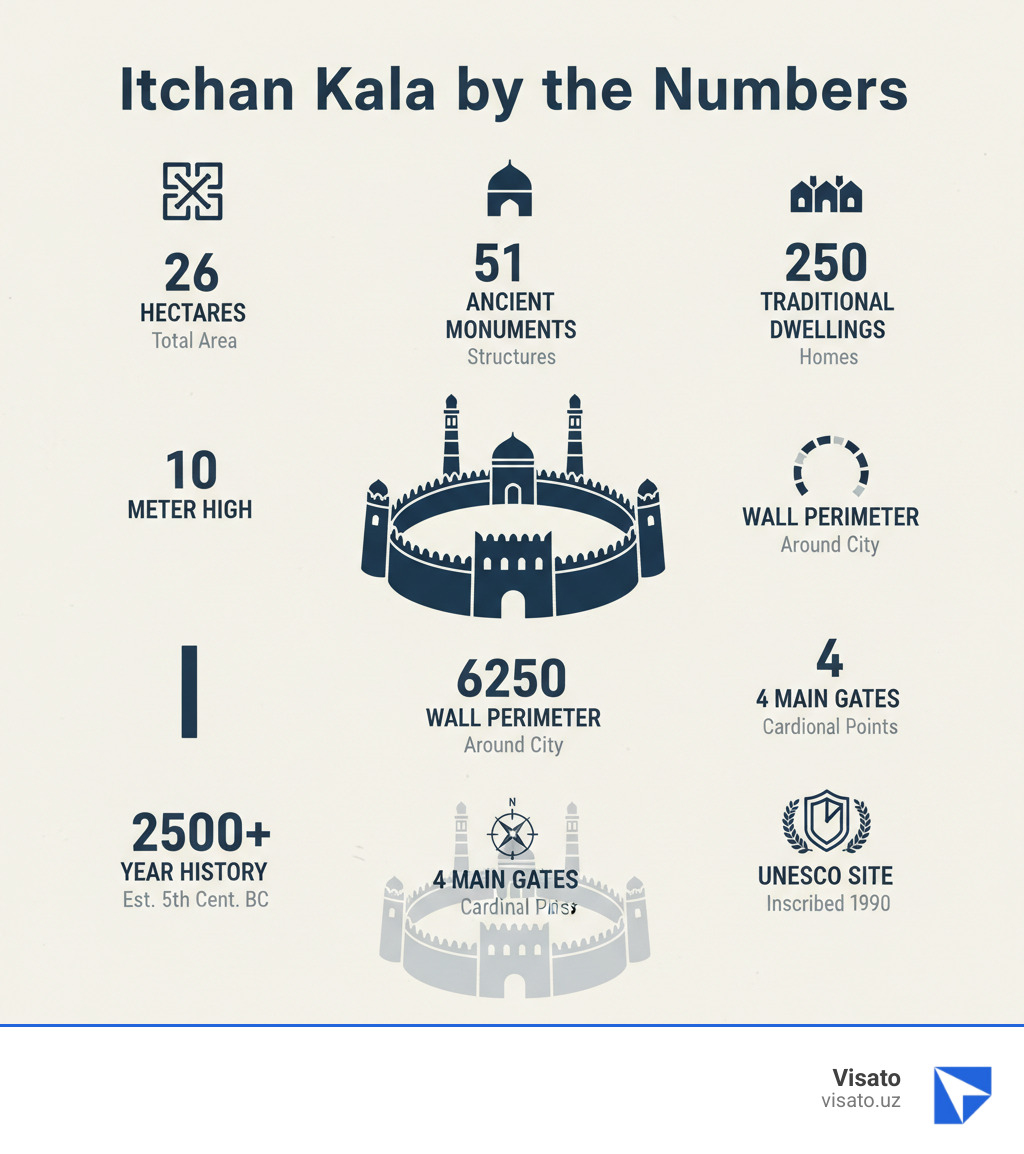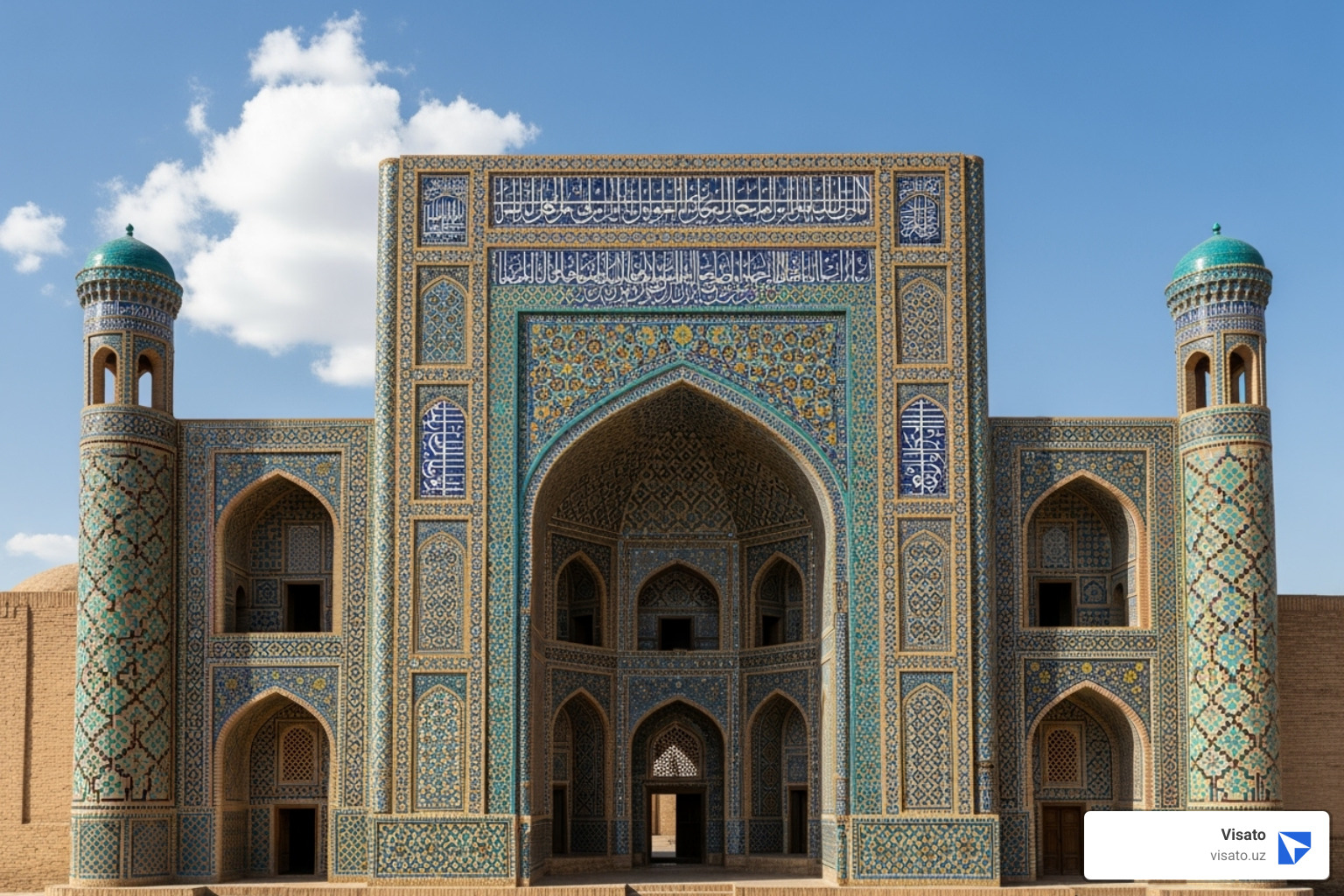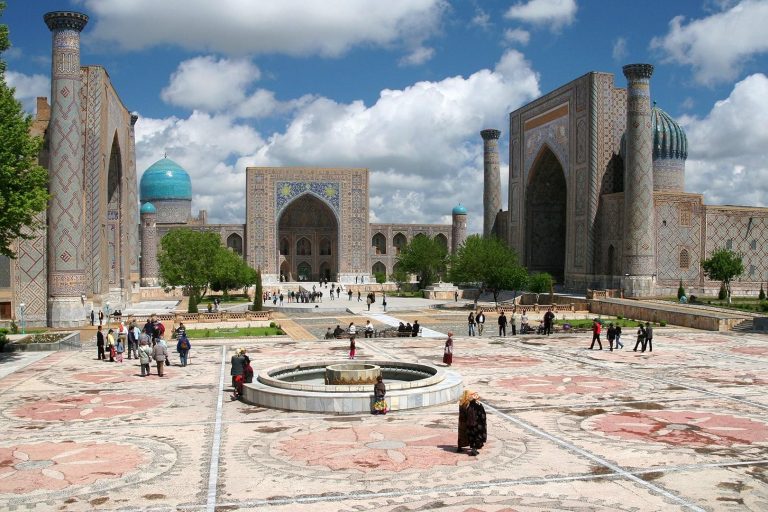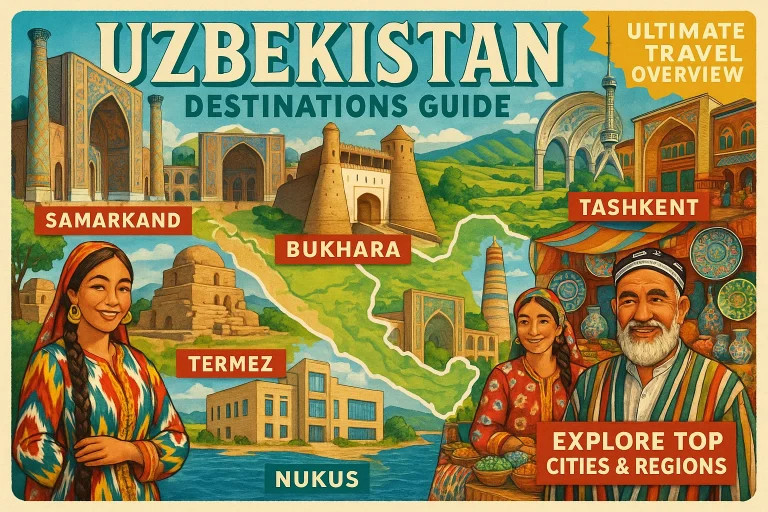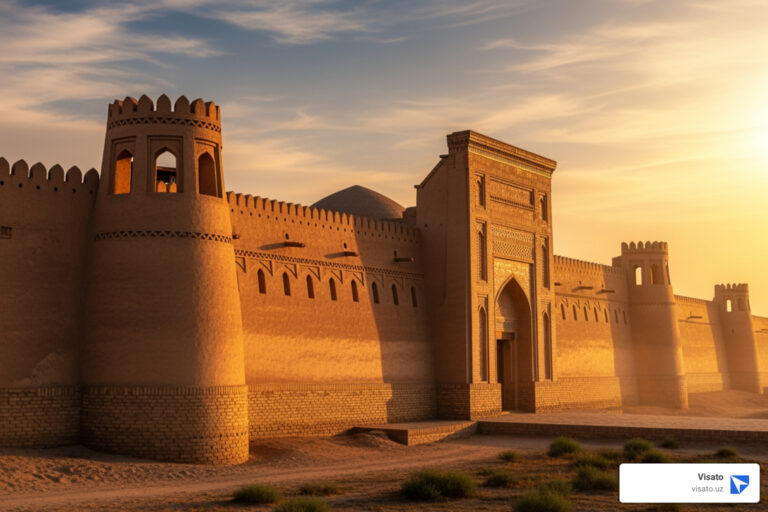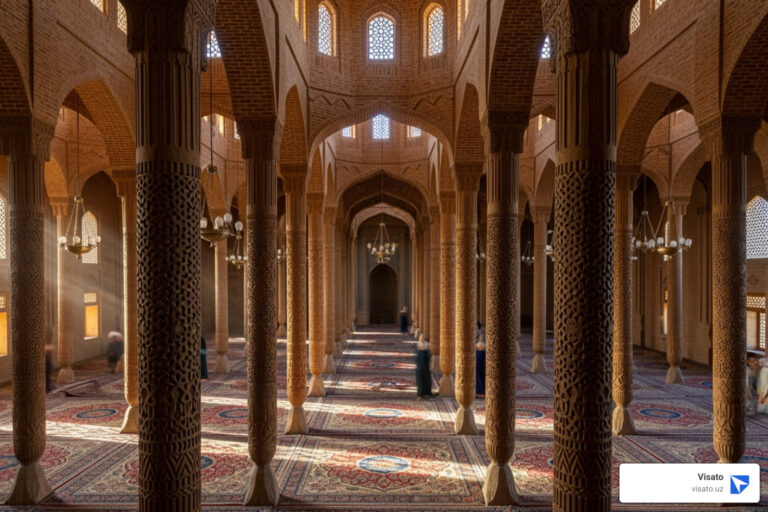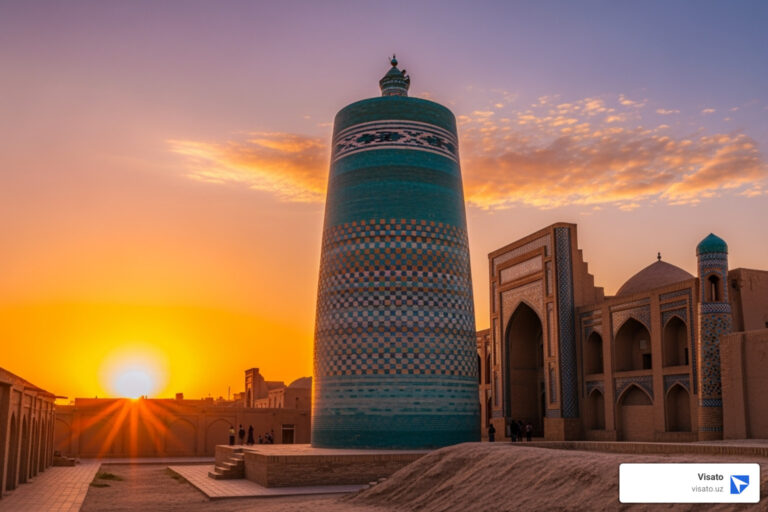Why Itchan Kala Khiva Stands as Central Asia’s Most Remarkable Walled City
Itchan Kala Khiva is the ancient walled inner city of Khiva, Uzbekistan—a UNESCO World Heritage Site that was the last resting place for caravans before crossing the desert to Iran. This living museum contains over 50 historic monuments and 250 traditional dwellings, all surrounded by 10-meter-high brick walls.
Quick Facts about Itchan Kala:
- Location: Inner city of Khiva, Khorezm Region, Uzbekistan
- Size: 26 hectares (650m x 400m rectangle)
- Monuments: 51+ ancient structures including mosques, madrasahs, and palaces
- Walls: 8-10 meters high, 5-6 meters thick, mud brick construction
- UNESCO Status: Inscribed 1990 (Criteria iii, iv, v)
- Entry Ticket: 150,000 Som (valid 48 hours)
- Best Time to Visit: Spring (April-May) and Autumn (September-October)
Unlike many historical sites, Itchan Kala is a complete medieval city frozen in time where approximately 2,600 people still live, making it a true living museum. It bears testimony to the lost civilizations of Khorezm and illustrates the development of Islamic architecture from the 14th to 19th centuries. From the unfinished Kalta Minor Minaret to the Juma Mosque’s carved columns, every corner tells a story of Central Asian craftsmanship.
I’m Nariman Huseynov from Visato. I’ve helped thousands of travelers steer visa requirements to experience Itchan Kala Khiva. Understanding what makes this site special helps travelers appreciate why the journey to Uzbekistan is worth it.
A Journey Through Time: The History of Itchan Kala Khiva
The history of Itchan Kala Khiva spans over two millennia, blending myth with historical fact. Its story is one of empires, Silk Road caravans, and the enduring Khorezm civilization.
The Legendary Origins
Khiva’s origins are traced back to a legend about Shem, one of Noah’s sons. After the Great Flood, Shem supposedly found a well in the desert and exclaimed “Khey vakh!” (“Oh, how pleasant!”), giving the city its name. The well, known as the Xeyvak Canal, is said to be the city’s foundation.
Beyond legend, archaeological evidence confirms Itchan Kala’s ancient roots. Its construction history spans four distinct periods, marked by cycles of destruction and renewal. The site bears exceptional testimony to the lost civilizations of Khorezm, one of Central Asia’s most powerful ancient states.
From Khanate Capital to Historical Relic
Positioned on the Silk Road, Khiva became the last major stop for caravans before the desert crossing to Iran. This strategic location turned it into a thriving commercial hub. The city’s golden age began in the 16th century when it became the capital of the Khiva Khanate. For three centuries, successive Khans commissioned magnificent mosques, madrasahs, and palaces, creating the coherent architectural ensemble we see today.
However, this prosperity was built partly on Central Asia’s largest slave market. When Russian slaves appeared in the market, the Russian Empire intervened, conquering the Khanate in 1873. Khiva’s independence ended, the old trade routes fell silent, and the city became isolated.
This isolation ironically saved Itchan Kala from modernization. During the Soviet period, its historical value was recognized. It was designated a state reserve in 1967, ensuring its preservation. Today, you step into a city that transitioned from a busy capital to a cherished living museum, where 2,600 residents still live among ancient monuments.
Architectural Wonders and Must-See Sights
Itchan Kala Khiva is an open-air gallery of Central Asian Islamic architecture, capturing centuries of evolution in one compact space. The city’s 50+ monuments form a visual timeline of styles from the 14th to 19th centuries.
Architectural Marvels within Itchan Kala Khiva
With so many structures, it’s helpful to focus on the must-see monuments that define Khiva’s architectural brilliance.
Kunha Ark Fortress: The “Old Citadel” was the heart of the Khiva Khanate, where Khans lived and ruled. The complex housed a palace, arsenal, barracks, and mosque. The watchtower offers panoramic views of the entire walled city, and its interior rooms are decorated with blue and white tiles.
Juma Mosque: First established in the 10th century, this mosque features a vast hall supported by 212 intricately carved wooden columns. Remarkably, 112 of these pillars were salvaged from ancient structures, some dating back to the 10th century. The dimly lit interior creates a mystical atmosphere.
Islam Khodja Minaret: At 57 meters, this is the highest point in Khiva. Built in the early 20th century, its slender form is wrapped in vibrant turquoise and blue tilework. It served as both a call-to-prayer tower and a watchtower. The climb to the top rewards you with breathtaking bird’s-eye views.
Pahlavon Mahmud Mausoleum: This is the resting place of Khiva’s patron saint—a 14th-century poet and wrestler. As a spiritual pilgrimage site, it showcases beautiful folk art. Remember to dress respectfully. This monument requires a separate entrance fee (around 25,000 Som).
Tash Khauli Palace: The “Stone Palace” was an 18th-century royal residence. This sprawling complex contains approximately 150 rooms across 9 courtyards, offering a glimpse into the luxurious life of the ruling elite.
Kalta Minor Minaret: Perhaps the most photographed structure in Khiva, this iconic tower is recognizable by its brilliant turquoise glazed tiles. It was intended to be the tallest minaret in Central Asia but construction halted in 1855, leaving it famously unfinished. Its incompleteness only adds to its charm.
The Mighty Walls and Gates
The formidable walls surrounding Itchan Kala Khiva are the reason it survived for centuries. Rising up to ten meters high and 5-6 meters thick, these mud-brick fortifications stretch 2.5 kilometers around the city. Watchtowers are positioned every 30 meters.
Four main gates, topped with blue-tiled domes, provide entry at the cardinal points:
- Ota Darvaza (West Gate): The main entrance for most visitors.
- Polvon Darvaza (East Gate): Historically led to the outer city and markets.
- Tosh Darvaza (South Gate): An imposing southern entrance.
- Bogcha Darvaza (North Gate): A quieter but equally impressive gate.
These gates were sophisticated defensive structures. Today, you can walk along sections of the walls, offering a unique perspective, especially at sunset.
A Practical Guide for Modern Explorers
Itchan Kala Khiva is a living city best explored on foot. Thoughtful planning will help you make the most of your visit to this ancient wonder.
Planning Your Visit to Itchan Kala Khiva
Best Time to Visit: The ideal times are spring (April-May) and autumn (September-October), when temperatures are pleasant (20-25°C). Summers can be scorching (40°C+), and winters are frigid.
Getting There: Most travelers fly from Tashkent to Urgench Airport (a 30-minute taxi ride from Khiva). Alternatively, Uzbekistan’s railway offers comfortable overnight trains from Tashkent or a 5-hour train from Bukhara. The Khiva train station is a short walk from the old city. Adventurous travelers can take a 7-8 hour taxi from Bukhara to see desert fortresses along the way.
Getting Around: The walled city is compact and entirely walkable. No transportation is needed inside the walls.
Tickets and Hours:
- Walking the main streets is free.
- To enter monuments and museums, you need a complex ticket costing 150,000 Som, which is valid for 48 hours. It can be purchased at the main gates.
- A few sites require separate tickets: the Pahlavon Mahmud Mausoleum (approx. 25,000 Som) and the Islam Khodja Minaret climb (approx. 100,000 Som).
- Most attractions are open from 8 AM to 6 PM daily. Arrive early to avoid crowds.
Visa Requirements: Uzbekistan has a straightforward e-visa system for most nationalities. At Visato, our streamlined online application takes just minutes, and we deliver e-visas in 2-3 business days with 24/7 support. For details, see our guide on more info about Uzbekistan e-visa requirements.
Unique Cultural Experiences
What makes Itchan Kala special is that it remains a living community.
- Local Artisans: Wander the streets and you’ll find wood carvers, stone carvers, and tile makers working in their studios, using techniques passed down through generations.
- Carpet Weaving: Khiva is renowned for its hand-woven silk carpets. Visit a workshop to see the painstaking process from dyeing threads to the final knotting.
- Local Cuisine: Try Khiva’s specialty, shivit oshi—green dill noodles topped with a meat or vegetable stew. Also, look for hot pumpkin samsas from street vendors.
- Sunset Views: For an unforgettable moment, climb the Kunha Ark Watchtower or find a spot on the city walls at sunset. The golden light bathing the mud-brick buildings is magical. Terrassa Café is another popular spot for this view.
- Bazaars: The bazaars offer a more intimate shopping experience than in larger cities. Find textiles, jewelry, wood carvings, and ceramics. Bargaining is part of the culture, so engage with good humor.
- Aladdin Connection: Many believe Itchan Kala inspired the city of Agrabah in Disney’s Aladdin. While unconfirmed, the resemblance is striking.
UNESCO Status and Preserving a Legacy
In 1990, UNESCO inscribed Itchan Kala Khiva as a World Heritage Site, recognizing it as a treasure of humanity. The designation was granted based on three key criteria:
Ichan Kala – UNESCO World Heritage Centre
- It bears exceptional testimony to the lost civilizations of Khorezm.
- It is an outstanding example of Islamic architecture from the 14th to 19th centuries, forming a coherent urban ensemble.
- Its traditional domestic architecture is a remarkable example of human adaptation to a desert climate.
What makes Itchan Kala special is its authenticity. The city has been carefully maintained, not reconstructed for tourism. The harmony between its medieval structure and later additions creates a genuine atmosphere.
Preserving a 2,500-year-old city faces constant threats like termite infestations and soil salinity. However, the site is under careful management by Uzbekistan’s Ministry of Culture and Sports. A dedicated Directorate oversees conservation, ensuring restoration work uses traditional techniques and locally sourced materials. This commitment ensures that future generations can experience the same wonder we do today.
For us at Visato, helping travelers reach this UNESCO masterpiece is about connecting people with our shared global heritage. Every e-visa we process helps someone witness this living museum and understand the importance of preservation.
Frequently Asked Questions about Itchan Kala
Here are answers to the most common questions we receive at Visato about planning a trip to Itchan Kala Khiva.
Is Itchan Kala worth visiting?
Absolutely. Itchan Kala is one of Central Asia’s most extraordinary destinations. It’s not just a collection of monuments but a living, breathing medieval city where 2,600 people reside. As the best-preserved Silk Road city you can experience today, its authentic atmosphere is transportive. The narrow alleys, brilliant tiles, and sound of artisans at work create an unforgettable experience. If you’re visiting Uzbekistan, Itchan Kala is a must-see.
How much does it cost to enter Itchan Kala?
Walking the streets of Itchan Kala is free. To enter the monuments and museums, you’ll need a complex ticket for approximately 150,000 Som, which is valid for 48 hours. A few sites, like the Pahlavon Mahmud Mausoleum (25,000 Som) and the Islam Khodja Minaret climb (100,000 Som), require separate tickets.
How many days do you need in Khiva?
One full day is enough to see the main sights within Itchan Kala, including the Kunha Ark Fortress, Juma Mosque, and Tash Khauli Palace. This gives you a solid overview of the city’s architectural wonders.
However, we recommend two days for a richer experience. This allows you to slow down, explore artisan workshops, linger over local food, and see the city at different times of day, like sunrise and sunset. Two days also opens up the possibility of a day trip to the nearby Khorezm desert fortresses (requires a private car).
Before you go, ensure your Uzbekistan e-visa is sorted. Visato can process your application in just 2-3 business days, letting you focus on planning your adventure.
Conclusion: Your Gateway to Uzbekistan’s Past
Itchan Kala Khiva is more than just a historical site; it’s a living portal to another time. Here, the whispers of Silk Road caravans echo through narrow streets, and master craftsmen continue ancient traditions. From its legendary origins to its towering minarets, Itchan Kala offers a rare authenticity. It’s a place where 2,600 people still call home, their lives intertwined with centuries of history.
Your experience here—climbing a minaret for a sunset view, tasting local delicacies, or simply wandering the sun-baked alleys—will stay with you long after you return home.
Getting there is easier than you might think. At Visato, we’ve streamlined the Uzbekistan e-visa process into a simple, secure online application. Most travelers receive their e-visas in just 2-3 business days, with our support team available 24/7.
Are you ready to step through the ancient gates of Central Asia’s most remarkable walled city? Your journey to Itchan Kala Khiva starts with a single step.

